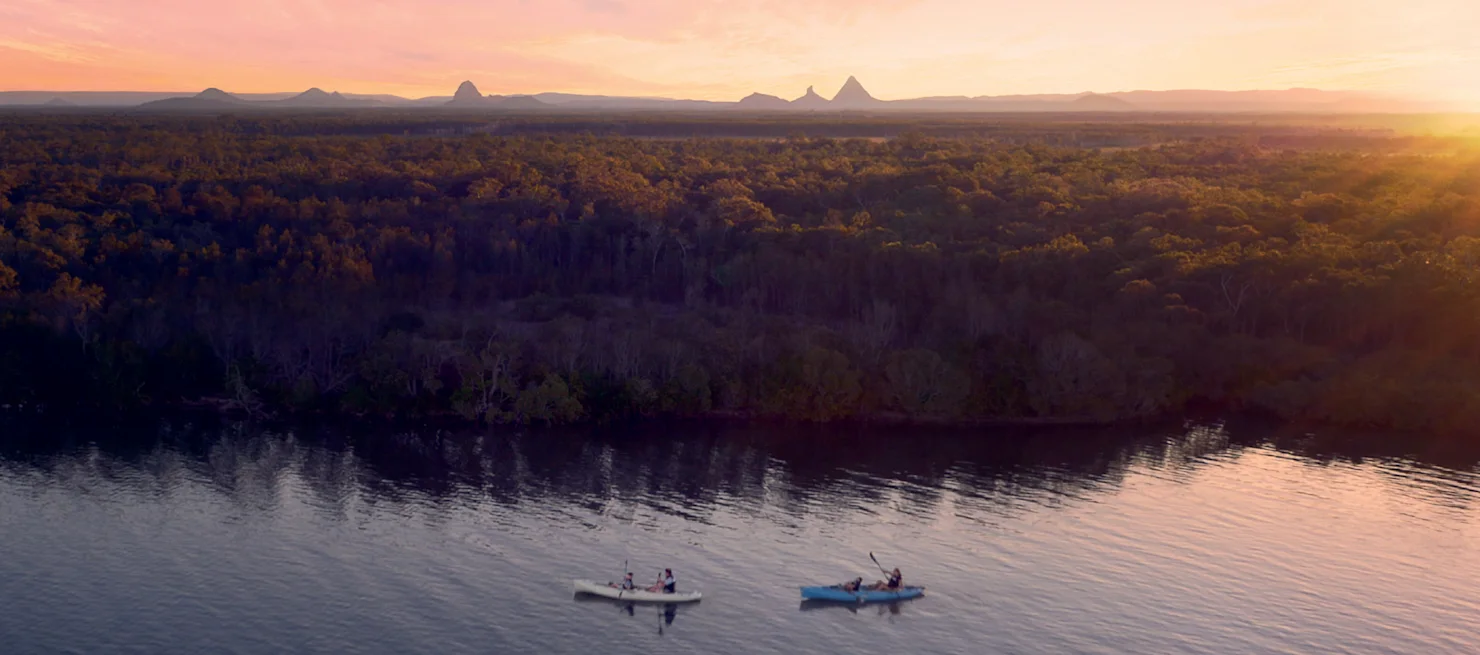Oh, the serenity
With over 60 national and conservation parks, the Sunshine Coast boasts almost half of Australia’s bird species, over 150 rare or endangered species, and unspoiled wetlands, rainforests and coastal health.
The Sunshine Coast is known for its rich biodiverse habitat, with some species found nowhere else in the world. Queensland’s tallest tree a 74-metre-high flooded gum Eucalyptus Grandis – can be found in Conondale National Park.
Breathe in the crisp air as you wander among tall open forests or spot platypus in crystal clear creeks. Choose from Amamoor or Imbil State Forests, and Kondalilla or Mapleton National Parks in the Sunshine Coast Hinterland, just to name a few.
Explore a beautiful coastline as you wind your way along the coastal path, and picnic with sweeping ocean views in popular Noosa National Park or the Great Sandy National Park. Camping is also offered in some of the region’s parks and forests. Remember to book your camp sites well in advance at qld.gov.au/camping.
Lace up and clip in
If more adventurous walks are your style, challenge yourself on a hike on the volcanic peaks of the Glass House Mountains. Mount Ngungun and Mount Tibrogargan are popular and easily accessible with stunning 360-degree views of the region.
Or try Mount Coolum near Coolum Beach on the coast. Climbing to the top of this 25-million-year-old laccolith is a must-do when visiting the region - the views from the top are absolutely spectacular.
Perhaps you have a few days to spare? The 58-kilometre Sunshine Coast Hinterland Great Walk and the 102-kilometre Cooloola Great Walk, recognised as part of the Great Walks of Queensland, will take you through some of the area’s most scenic and little-known locations.
Mountain biking is another fun and active way to explore the hinterland and forests, with escorted tours or hiring options available to get you on your way on the trails.
Top 4 natural highlights
The Glass House Mountains are magnificent rocky outcrops and are actually remnants of volcanic activity that occurred about 25 million years ago. As the volcanic mountains cooled, stunning vertical columns emerged. Today, they have become iconic landmarks on the Sunshine Coast and a popular location for bushwalkers and hikers to explore. The most notable peaks are Mount Beerwah, Mount Tibrogargan, Mount Coochin and Mount Coonowrin, all located within the Glass House Mountains National Park.
The Noosa Everglades is one of only two everglade systems in the world. For the ultimate in serene tranquillity, the area is best explored on an eco-cruise or in a kayak. There are banksias, tea trees, melaleucas, reeds and water lilies along the water’s edge. Marvel at the reflections of the flora on the banks of the water that appear like a mirage; it’s no surprise that the upper reaches of the Noosa River is often referred to as the River of Mirrors.
The Pumicestone Passage Marine Park consists of 24 islands and 240 kilometres of shoreline, and with 80 percent of the waterway measuring under two metres deep, it is the perfect place to explore on a stand-up paddle board, kayak or escorted jet ski tour. The dugong is the world’s only marine mammal herbivore and if you’re lucky, you’ll get to spot one of these placid creatures popping its nose out of the water in the Pumicestone Passage (seasonal).
One of the most spectacular things about The Great Sandy National Park section of coastline is the multi-coloured rocks and sand that have been created by iron-rich minerals in the dunes which, over thousands of years, have stained the sand into a variety of shades of yellow, red, orange and brown. Also worth checking out is Carlo Sand Blow’s breathtaking views of Double Island Point, Tin Can Bay, the coloured sands and K’gari (formerly Fraser Island).
Great Beach Drive
If you want to get off the beaten track, head for the Great Sandy National Park and take to the beach in your 4WD. Cruise along the shoreline, marvel at the coastal cliffs and coloured sands, throw in your fishing line and catch yourself dinner.
You’ll need a vehicle permit to drive along the sand and there are some places where camping is restricted, so be sure to check the signs before you set off on your adventure, or alternatively book a tour.
Packed with a diversity of nature and wildlife, this area represents the only place in the world where there are two adjoining Biosphere Reserves recognised by UNESCO: the Noosa Biosphere and Great Sandy Biosphere.








